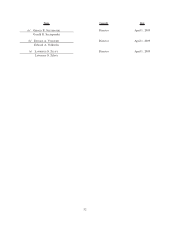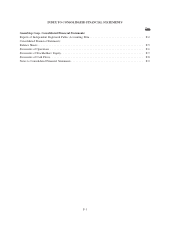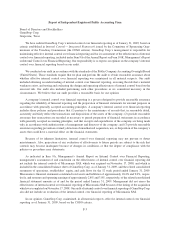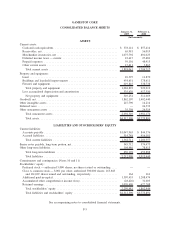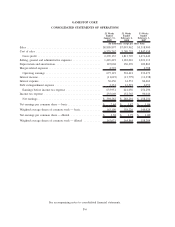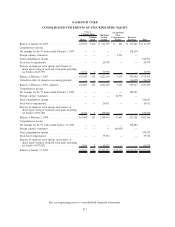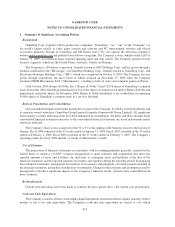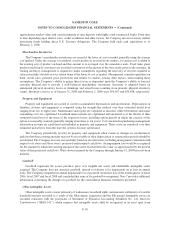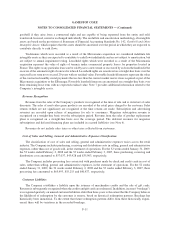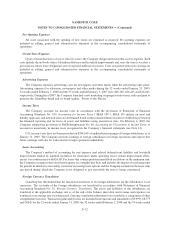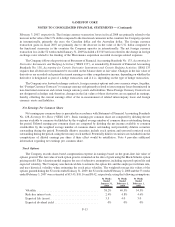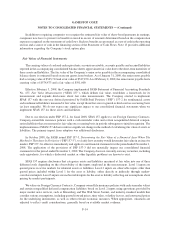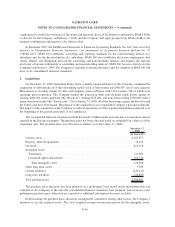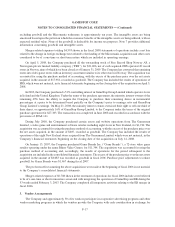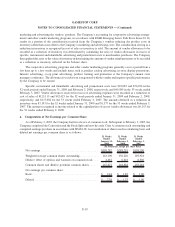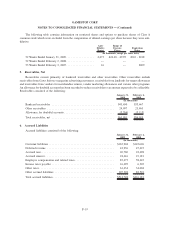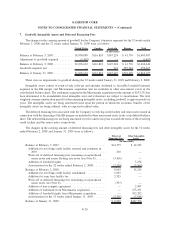GameStop 2008 Annual Report Download - page 77
Download and view the complete annual report
Please find page 77 of the 2008 GameStop annual report below. You can navigate through the pages in the report by either clicking on the pages listed below, or by using the keyword search tool below to find specific information within the annual report.approximates market value, and consist primarily of time deposits with highly rated commercial banks. From time
to time depending upon interest rates, credit worthiness and other factors, the Company invests in money market
investment funds holding direct U.S. Treasury obligations. The Company held such cash equivalents as of
February 2, 2008.
Merchandise Inventories
The Company’s merchandise inventories are carried at the lower of cost or market generally using the average
cost method. Under the average cost method, as new product is received from vendors, its current cost is added to
the existing cost of product on-hand and this amount is re-averaged over the cumulative units. Used video game
products traded in by customers are recorded as inventory at the amount of the store credit given to the customer. In
valuing inventory, management is required to make assumptions regarding the necessity of reserves required to
value potentially obsolete or over-valued items at the lower of cost or market. Management considers quantities on
hand, recent sales, potential price protections and returns to vendors, among other factors, when making these
assumptions. The Company’s ability to gauge these factors is dependent upon the Company’s ability to forecast
customer demand and to provide a well-balanced merchandise assortment. Inventory is adjusted based on
anticipated physical inventory losses or shrinkage and actual losses resulting from periodic physical inventory
counts. Inventory reserves as of January 31, 2009 and February 2, 2008 were $56,567 and $59,698, respectively.
Property and Equipment
Property and equipment are carried at cost less accumulated depreciation and amortization. Depreciation on
furniture, fixtures and equipment is computed using the straight-line method over their estimated useful lives
ranging from two to eight years. Maintenance and repairs are expensed as incurred, while betterments and major
remodeling costs are capitalized. Leasehold improvements are capitalized and amortized over the shorter of their
estimated useful lives or the terms of the respective leases, including option periods in which the exercise of the
option is reasonably assured (generally ranging from three to ten years). Costs incurred in purchasing management
information systems are capitalized and included in property and equipment. These costs are amortized over their
estimated useful lives from the date the systems become operational.
The Company periodically reviews its property and equipment when events or changes in circumstances
indicate that their carrying amounts may not be recoverable or their depreciation or amortization periods should be
accelerated. The Company assesses recoverability based on several factors, including management’s intention with
respect to its stores and those stores’ projected undiscounted cash flows. An impairment loss would be recognized
for the amount by which the carrying amount of the assets exceeds their fair value, as approximated by the present
value of their projected cash flows. Write-downs incurred by the Company through January 31, 2009 have not been
material.
Goodwill
Goodwill represents the excess purchase price over tangible net assets and identifiable intangible assets
acquired. The Company does not amortize goodwill, instead it evaluates it for impairment on at least an annual
basis. The Company completed its annual impairment test of goodwill on the first day of the fourth quarter of fiscal
2006, fiscal 2007 and fiscal 2008 and concluded that none of its goodwill was impaired. Note 7 provides additional
information concerning the changes in goodwill for the consolidated financial statements presented.
Other Intangible Assets
Other intangible assets consist primarily of tradenames, leasehold rights and amounts attributed to favorable
leasehold interests recorded as a result of the Micromania acquisition and the EB merger. Intangible assets are
recorded consistent with the provisions of Statement of Financial Accounting Standards No. 141, Business
Combinations (“SFAS 141”), which requires that intangible assets shall be recognized as an asset apart from
F-10
GAMESTOP CORP.
NOTES TO CONSOLIDATED FINANCIAL STATEMENTS — (Continued)


